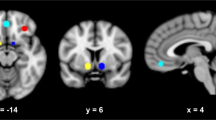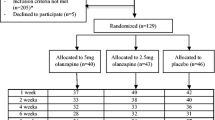Abstract
Rationale
The available treatments for alcoholism are only modestly effective, and patients vary widely in their treatment response. Quetiapine, an atypical antipsychotic medication with antagonist activity at D1 and D2, 5-HT1A and 5-HT2A, H1, and α1 and α2 receptors was shown to promote abstinence, reduce drinking days, and reduce heavy drinking days in a 12-week double-blind placebo-controlled trial.
Objective
Although quetiapine represents one of the promising pharmacotherapies for the treatment of alcoholism, its mechanisms of action are poorly understood. The objective of this study is to elucidate the biobehavioral mechanisms of action of quetiapine for alcoholism, by examining its effects on subjective intoxication and craving.
Method
A total of 20 non-treatment-seeking alcohol-dependent individuals were randomized to one of the following conditions in a double-blind, placebo-controlled design: (1) quetiapine (400 mg/day); or (2) matched placebo. Participants were on the target medication dose (or matched placebo) for 4 weeks during which they completed weekly assessments of drinking, sleep, mood, and anxiety. Participants completed two counterbalanced intravenous placebo-alcohol administration sessions as well as cue-reactivity assessments.
Results
Analyses revealed a significant effect of quetiapine in reducing craving during the alcohol administration, the alcohol cue-exposure, and the weekly reports of alcohol craving. Quetiapine was also found to reduce subjective intoxication and alcohol-induced sedation during the alcohol administration paradigm.
Conclusions
This study contributes critical new information about mechanisms of response to quetiapine for alcoholism, which, in turn, can inform larger-scale studies and ultimately, clinical practice.




Similar content being viewed by others
References
Anton RF, Moak DH, Latham P (1995) The obsessive compulsive drinking scale: a self-rated instrument for the quantification of thoughts about alcohol and drinking behavior. Alcohol Clin Exp Res 19:92–99
Anton RF, Moak DH, Latham PK (1996) The obsessive compulsive drinking scale: a new method of assessing outcome in alcoholism treatment studies. Arch Gen Psychiatry 53:225–231
Atmaca M, Kuloglu M, Tezcan E (2005) A new atypical antipsychotic: quetiapine-induced sexual dysfunctions. Int J Impot Res 17:201–203
Babiker IE, Cooke PR, Gillett MG (1989) How useful is riboflavin as a tracer of medication compliance? J Behav Med 12:25–38
Babor TF, Hofmann M, DelBoca FK, Hesselbrock V, Meyer RE, Dolinsky ZS, Rounsaville B (1992) Types of alcoholics. I. Evidence for an empirically derived typology based on indicators of vulnerability and severity. Arch Gen Psychiatry 49:599–608
Beck AT, Epstein N, Brown G, Steer RA (1988) An inventory for measuring clinical anxiety: psychometric properties. J Consult Clin Psychol 56:893–897
Besson M, Belin D, McNamara R, Theobald DE, Castel A, Beckett VL, Crittenden BM, Newman AH, Everitt BJ, Robbins TW, Dalley JW (2010) Dissociable control of impulsivity in rats by dopamine d2/3 receptors in the core and shell subregions of the nucleus accumbens. Neuropsychopharmacology 35:560–569
Bohn MJ, Krahn DD, Staehler BA (1995) Development and initial validation of a measure of drinking urges in abstinent alcoholics. Alcohol Clin Exp Res 19:600–606
Buysse DJ, Reynolds CF 3rd, Monk TH, Berman SR, Kupfer DJ (1989) The Pittsburgh sleep quality index: a new instrument for psychiatric practice and research. Psychiatry Res 28:193–213
Croissant B, Klein O, Gehrlein L, Kniest A, Hermann D, Diehl A, Mann K (2006) Quetiapine in relapse prevention in alcoholics suffering from craving and affective symptoms: a case series. Eur Psychiatry 21:570–573
Del Boca FK, Kranzler HR, Brown J, Korner PF (1996) Assessment of medication compliance in alcoholics through UV light detection of a riboflavin tracer. Alcohol Clin Exp Res 20:1412–1417
Erblich J, Earleywine M (1995) Distraction does not impair memory during intoxication: support for the attention-allocation model. J Stud Alcohol 56:444–448
First MB, Spitzer RL, Gibbon M, Williams JBW (1995) Structured Clinical Interview for DSM-IV Axis I Disorders - Patient edition (SCID-I/P, version 2.0). . Biometrics Research Department, New York State Psychiatric Institute., Biometrics Research Department, New York State Psychiatric Institute
Flannery BA, Volpicelli JR, Pettinati HM (1999) Psychometric properties of the Penn Alcohol Craving Scale. Alcohol Clin Exp Res 23:1289–1295
Guardia J, Roncero C, Galan J et al. (2011) A double-blind, placebo-controlled, randomized pilot study comparing quetiapine with placebo, associated to naltrexone, in the treatment of alcohol-dependent patients. Addict Behav
Horacek J, Bubenikova-Valesova V, Kopecek M, Palenicek T, Dockery C, Mohr P, Hoschl C (2006) Mechanism of action of atypical antipsychotic drugs and the neurobiology of schizophrenia. CNS Drugs 20:389–409
Jacobson AF, Goldstein BJ, Dominguez RA, Steinbook RM (1986) Interrater agreement and intraclass reliability measures of SAFTEE in psychopharmacologic clinical trials. Psychopharmacol Bull 22:382–388
Kampman KM, Pettinati HM, Lynch KG, Whittingham T, Macfadden W, Dackis C, Tirado C, Oslin DW, Sparkman T, O'Brien CP (2007) A double-blind, placebo-controlled pilot trial of quetiapine for the treatment of Type A and Type B alcoholism. J Clin Psychopharmacol 27:344–351
Levine J, Schooler NR (1986) SAFTEE: a technique for the systematic assessment of side effects in clinical trials. Psychopharmacol Bull 22:343–381
Lindberg N, Tani P, Takala P, Sailas E, Putkonen H, Eronen M, Virkkunen M (2006) Increased deep sleep in a medication-free, detoxified female offender with schizophrenia, alcoholism and a history of attempted homicide: effect of concomitant administration of quetiapine and citalopram. Crim Behav Ment Health 16:60–66
MacKillop J (2006) Factor structure of the alcohol urge questionnaire under neutral conditions and during a cue-elicited urge state. Alcohol Clin Exp Res 30:1315–1321
Martin CS, Earleywine M, Musty RE, Perrine MW, Swift RM (1993) Development and validation of the Biphasic Alcohol Effects Scale. Alcohol Clin Exp Res 17:140–146
Martinotti G, Andreoli S, Di Nicola M, Di Giannantonio M, Sarchiapone M, Janiri L (2008) Quetiapine decreases alcohol consumption, craving, and psychiatric symptoms in dually diagnosed alcoholics. Hum Psychopharmacol 23:417–424
Menon A, Williams RH, Watson S (2006) Increased libido associated with quetiapine. J Psychopharmacol 20:125–127
Monnelly EP, Ciraulo DA, Knapp C, LoCastro J, Sepulveda I (2004) Quetiapine for treatment of alcohol dependence. J Clin Psychopharmacol 24:532–535
Monti PM, Binkoff JA, Abrams DB, Zwick WR, Nirenberg TD, Liepman MR (1987) Reactivity of alcoholics and nonalcoholics to drinking cues. J Abnorm Psychol 96:122–126
Monti PM, Rohsenow DJ, Swift RM, Gulliver SB, Colby SM, Mueller TI, Brown RA, Gordon A, Abrams DB, Niaura RS, Asher MK (2001) Naltrexone and cue exposure with coping and communication skills training for alcoholics: treatment process and 1-year outcomes. Alcohol Clin Exp Res 25:1634–1647
Novick D, Haro JM, Perrin E, Suarez D, Texeira JM (2009) Tolerability of outpatient antipsychotic treatment: 36-month results from the European Schizophrenia Outpatient Health Outcomes (SOHO) study. Eur Neuropsychopharmacol 19:542–550
Pezze MA, Dalley JW, Robbins TW (2007) Differential roles of dopamine D1 and D2 receptors in the nucleus accumbens in attentional performance on the five-choice serial reaction time task. Neuropsychopharmacology 32:273–283
Potvin S, Stip E, Lipp O, Elie R, Mancini-Marie A, Demers MF, Roy MA, Bouchard RH, Gendron A (2006) Quetiapine in patients with comorbid schizophrenia-spectrum and substance use disorders: an open-label trial. Curr Med Res Opin 22:1277–1285
Ray LA, Hutchison KE (2004) A polymorphism of the mu-opioid receptor gene (OPRM1) and sensitivity to the effects of alcohol in humans. Alcohol Clin Exp Res 28:1789–1795
Ray LA, Meskew-Stacer S, Hutchison KE (2007) The relationship between prospective self-rating of alcohol sensitivity and craving and experimental results from two alcohol challenge studies. J Stud Alcohol Drugs 68:379–384
Ray LA, MacKillop J, Leventhal A, Hutchison KE (2009) Catching the alcohol buzz: an examination of the latent factor structure of subjective intoxication. Alcohol Clin Exp Res 33:2154–2161
Ray LA, Heydari A, Zorick T (2010a) Quetiapine for the treatment of alcoholism: scientific rationale and review of the literature. Drug Alcohol Rev 29:568–575
Ray LA, Hutchison KE, Tartter M (2010b) Application of human laboratory models to pharmacotherapy development for alcohol dependence. Curr Pharm Des 16:2149–2158
Roberts JS, Anton RF, Latham PK, Moak DH (1999) Factor structure and predictive validity of the Obsessive Compulsive Drinking Scale. Alcohol Clin Exp Res 23:1484–1491
Sattar SP, Bhatia SC, Petty F (2004) Potential benefits of quetiapine in the treatment of substance dependence disorders. J Psychiatry Neurosci 29:452–457
Schuckit MA (1984) Subjective responses to alcohol in sons of alcoholics and control subjects. Arch Gen Psychiatry 41:879–884
Sobell LC, Sobell MB (1980) Convergent validity: an approach to increasing confidence in treatment outcome conclusions with alcohol and drug abusers. In: Sobell LC, Sobell MB, Ward E (eds) Evaluating Alcohol and Drug Abuse Treatment Effectiveness: Recent Advances. Pergamon Press, Elmsford, pp 177–183
Stedman M, Pettinati HM, Brown ES, Kotz M, Calabrese JR, Raines S (2010) A double-blind, placebo-controlled study with quetiapine as adjunct therapy with lithium or divalproex in bipolar I patients with coexisting alcohol dependence. Alcohol Clin Exp Res 34:1822–1831
Stritzke WG, Patrick CJ, Lang AR (1995) Alcohol and human emotion: a multidimensional analysis incorporating startle-probe methodology. J Abnorm Psychol 104:114–122
Van den Eynde F, Senturk V, Naudts K, Vogels C, Bernagie K, Thas O, van Heeringen C, Audenaert K (2008) Efficacy of quetiapine for impulsivity and affective symptoms in borderline personality disorder. J Clin Psychopharmacol 28:147–155
Wiers RW (2008) Alcohol and drug expectancies as anticipated changes in affect: negative reinforcement is not sedation. Subst Use Misuse 43:429–444
Acknowledgments
This study was supported by seed funds from the Department of Psychology at the University of California Los Angeles (UCLA) and by NIH/NCRR grant number M01-RR00865. The authors wish to thank Ryan Arellano, Ellen Chang, Belinda De La Torre, Ana Heydari, and Spencer Bujarski for their contribution to data collection and data management for this project.
Conflict of interest
None of the authors have any conflicts of interest to report.
Author information
Authors and Affiliations
Corresponding author
Rights and permissions
About this article
Cite this article
Ray, L.A., Chin, P.F., Heydari, A. et al. A human laboratory study of the effects of quetiapine on subjective intoxication and alcohol craving. Psychopharmacology 217, 341–351 (2011). https://doi.org/10.1007/s00213-011-2287-3
Received:
Accepted:
Published:
Issue Date:
DOI: https://doi.org/10.1007/s00213-011-2287-3




